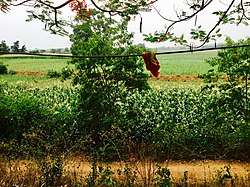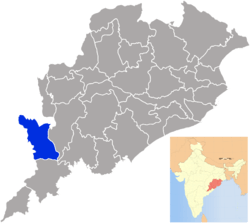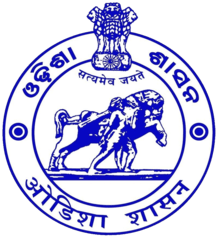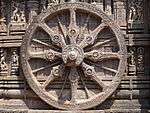Nabarangpur district
Nabarangpur district, also known as Nabarangapur district and Nawarangpur district, is a district of Odisha, India. The city of Nabarangpur is the district capital. Most of its population is tribal and the land is heavily forested. It borders the Kalahandi and Koraput districts. Nabarangpur district is situated at 19.14′ latitude and 82.32′ longitude at an average elevation of 1,876 feet (572 m).
Nabarangpur district | |
|---|---|
 | |
 Location in Odisha, India | |
| Coordinates: 19.23°N 82.55°E | |
| Country | |
| State | Odisha |
| Headquarters | Nabarangpur |
| Government | |
| • Collector & District Magistrate | Dr Ajit Kumar Mishra, OAS (SAG) |
| • Divisional Forest Officer Cum Wildlife Warden | Shri k.r parida, [OFS-1] |
| • Superintendent of Police | Shri Vivekananda Sharma, IPS |
| Area | |
| • Total | 5,294 km2 (2,044 sq mi) |
| Elevation | 195 m (640 ft) |
| Population (2011) | |
| • Total | 1,220,946 |
| • Density | 192/km2 (500/sq mi) |
| Languages | |
| • Official | Odia |
| • Local | Odia |
| Time zone | UTC+5:30 (IST) |
| PIN | 764 059 |
| Vehicle registration | OD-24 |
| Sex ratio | 1.007 ♂/♀ |
| Lok Sabha constituency | Nabarangpur(ST) |
| Vidhan Sabha constituency | 4
|
| Climate | Aw (Köppen) |
| Precipitation | 1,691 millimetres (66.6 in) |
| Avg. summer temperature | 40 °C (104 °F) |
| Avg. winter temperature | 12 °C (54 °F) |
| Website | www |
| This article is part of a series on |
| Odisha |
|---|
 |
| Governance |
|
| Topics |
| GI Products |
|
|
Districts Divisions |
|
|
History
The modern district of Nabarangpur was under the territory of the Suryavanshi kings of Jeypore until the dissolution of the princely state in 1951. Historically, the Gajapati kingdom collapsed in 1541 following the death of Prataparudra Deva and successive assassinations of his successors by the royal minister, Govind Vidyadhar. As a result, Vishwanath Dev, ruler of Nandapur and a former feudal lord of Pratap Rudra conquered a large territory that touched Bengal in the north to river Godavari in the south and stretched up to Visakhapatanam in the east till the kingdom of Bastar in the west.[1]
Later, Vikram Dev I (1758-1781 CE) of Jeypore appointed his second son Jagganath Dev as the zamindar of Nowrangpur.[2]
Economy
In 2006, the Ministry of Panchayati Raj named Nabarangpur one of the country's 250 poorest districts (out of a total of 640).[3] It is one of the 19 districts in Odisha currently receiving funds from the Backward Regions Grant Fund Programme (BRGF).[3]
Demographics
According to the 2011 Census of India Nabarangpur district has a population of 1,220,946, ranking it the 390th in population (out of a total of 640).[4] The district has a population density of 230 inhabitants per square kilometre (600/sq mi).[4] Its population growth rate over the decade 2001-2011 was 18.81%.[4] Nabarangapur has a sex ratio of 1018 females for every 1000 males[4] and a literacy rate of 48.2%. Scheduled Castes are 14.5% of the population while Scheduled Tribes are 55.8%.[4]
At the time of the 2011 census, 71.13% of the population in the district spoke Odia, 7.12% Bhatri, 4.50% Gondi, 4.41% Bengali, 4.28% Chhattisgarhi, 1.90% Halbi, 1.57% Kui and 1.40% Kuvi as their first language.[5] Major Odia dialects of the region include Desiya Odia.
Vidhan sabha constituencies
The following are the four Vidhan sabha constituencies of Nabarangpur district and the elected members[6] of that area:
| No. | Constituency | Reservation* | Extent of the Assembly Constituency (Blocks) | Member of 14th Assembly | Party |
|---|---|---|---|---|---|
| 73 | Umarkote | ST | Raighar, Umarkote (NAC), Umarkote (part) | Nityananda Gond | BJP |
| 74 | Jharigam | ST | Jharigam, Chandahandi, Umarkote (part) | Prakash Chandra Majhi | BJD |
| 75 | Nabarangpur | ST | Nabarangpur (M), Nabarangpur, Tentulikhunti, Nandahandi, Kosagumuda (part) | Sadasiva Pradhani | BJD |
| 76 | Dabugam | ST | Dabugam, Papadahandi, Kosagumuda (part) | Manohar Randhari | BJD |
* Since all seats of Nabarangpur district are covered by ST Seats no SC seat is assigned.
| Year | Pop. | ±% p.a. |
|---|---|---|
| 1901 | 180,597 | — |
| 1911 | 217,118 | +1.86% |
| 1921 | 210,348 | −0.32% |
| 1931 | 248,072 | +1.66% |
| 1941 | 294,084 | +1.72% |
| 1951 | 330,476 | +1.17% |
| 1961 | 422,325 | +2.48% |
| 1971 | 547,944 | +2.64% |
| 1981 | 681,579 | +2.21% |
| 1991 | 846,659 | +2.19% |
| 2001 | 1,025,766 | +1.94% |
| 2011 | 1,220,946 | +1.76% |
| Source:[7] | ||
References
- Presidency, Madras (1866). The Fifth Annual Report from the Select Committee on the Affairs of the East India Company (First ed.). United Scottish Press, London: Graves, Cookson & Co. p. 141,217. Retrieved 17 September 2019.
- Singh Deo 1939, p. 8.
- Ministry of Panchayati Raj (September 8, 2009). "A Note on the Backward Regions Grant Fund Programme" (PDF). National Institute of Rural Development. Archived from the original (PDF) on April 5, 2012. Retrieved September 27, 2011.
- "District Census 2011". Census2011.co.in. 2011. Retrieved 2011-09-30.
- 2011 Census of India, Population By Mother Tongue
- "List of Member in Fourteenth Assembly". ws.ori.nic.in. Archived from the original on 2 May 2007. Retrieved 19 February 2013.
MEMBER NAME
- Decadal Variation In Population Since 1901
- Singh Deo, Kumar Bidyadhar (1939). Nandapur A Forsaken Kingdom. Utkal Sahitya Press. ISBN 978-81-86772-17-1.CS1 maint: ref=harv (link)
